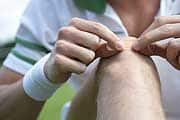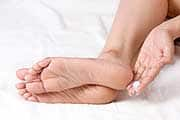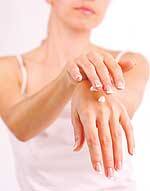Life Extension Magazine®
One of the frustrations expressed by some aging people is that they develop degenerative skin lesions (such as ulcers on the foot and lower extremities) that do not readily heal. In other instances, minor trauma, venous insufficiency, or inflammatory reactions create an open wound that lingers far too long. The reason these problems are so bothersome is that in youth these kinds of skin problems resolved themselves in a few days. Yet we now develop skin lesions that seem to never completely go away. Life Extension® asked dermatologist Gary Goldfaden to look into this annoying problem to see what can be done about it. This article describes why painful and unsightly lesions develop in aging skin and what can be used to accelerate a resolution. The degradation of skin and vascular tissue that comes with aging produces unsightly, often painful effects. To take one example, varicose veins now affect half of all people aged 50 or older.1 The list of age-related cosmetic defects and abnormalities is a long one. Pooled blood from ruptured capillaries; chronic bruising that takes months to heal; collecting of fluids and swelling beneath the skin; inflamed, distended spider veins and areas of discoloration. You may have seen these or other age-related skin deformities in elderly individuals. You may suffer from some of them yourself. While medical interventions (injections, surgery, artificial creams, and ointments) can be painful, costly, and unreliable, a body of clinical evidence is emerging that supports low-cost, natural solutions to these and other age-related skin disfigurements. The unique properties of topically-applied vitamin K, extracts of the wildflower Arnica montana and oats, along with vitamin D can speed skin healing and combat age-related degradation. Taken together, their synergistic action offers a multitargeted approach that protects your skin and ensures its youthful, healthy appearance despite advancing age. Common Culprits of Skin DisfigurementAside from sports injuries sustained in your younger years, many cosmetic procedures cause bruising and swelling. Whether through surgery, an injection of a dermal filler or Botox®, a vascular laser treatment, or liposuction, the resulting trauma can lead to blood leakage from ruptured arteries and veins and a pooling of fluids. This blood ultimately collects and dries in a deposit of disintegrating red blood cells (called hemosiderin), leaving a visible discoloration that changes hue as the blood undergoes various chemical reactions. Other fluids that accumulate at the wound site also cause swelling that can increase the visibility of the bruise.
Aside from cuts, scrapes, and bruises, the passage of time inflicts a number of destructive physical alterations on your skin. Many of the surface imperfections seen in older skin are actually the result of progressive damage to the skin’s vascular system. As you age, the outermost layer of your skin begins to suffer from a loss of vertical capillary loops that supply much-needed oxygen and nutrients to the skin. It gradually thins, rendering the underlying blood vessels much more susceptible to injury. In many older people a condition known as purpura senilis develops, in which extreme bruising on the hands, arms, and legs can occur from the slightest contact and may take many months to heal. With advancing age there is also a marked decrease in the number of “veil” cells, fibroblast-like cells that surround small vessels in the skin’s dermis. They’re responsible for depositing basement membrane materials around blood vessels in response to vascular damage. Cumulative exposure to ultraviolet light can also degrade the underlying collagen that supports blood vessels, creating an environment in which these tiny capillaries become stretched and permanently dilated by the pressure from larger veins. This abnormal dilation gradually weakens the capillary walls, causing the unsightly red spots and spidery veins (known as telangiectasia) that can often appear on the nose and cheeks. Weakened capillary walls are more prone to rupture, which can cause blood to leak out and flow along pathways made by surrounding capillaries. Escaped blood from facial capillaries around the eyes can also appear on the surface as dark circles. Fortunately, all these conditions, from accidental trauma to age-related skin defects, can be effectively treated with a variety of clinically proven, natural topical interventions. Halt Subcutaneous Bleeding with Vitamin KVitamin K1 is a fat-soluble vitamin that activates the proteins involved in blood clotting (coagulation), which prevents unchecked bleeding or hemorrhaging throughout the body. It is an essential cofactor in the synthesis of at least 6 of the 13 proteins needed for coagulation. Because of its fat-soluble nature and importance in healthy blood clotting, vitamin K1 is ideal as a topical treatment for all disorders arising from vascular injury. When applied topically, vitamin K1 readily penetrates the pores of the skin and is transported deep into the dermis where it effectively targets damaged capillaries. Vitamin K1 functions naturally to support the blood clotting process and end seepage, eventually permitting the skin tissue to heal itself. The impressive recuperative benefits of vitamin K1 have long been recognized by plastic surgeons, who have used vitamin K creams for many years to minimize post-procedure bruising and scarring.2,3 In one clinical study on the healing power of vitamin K1, patients suffering from blood vessel and skin disorders caused by trauma, surgery, or sun damage were treated using a vitamin K1 cream. At the end of 6 weeks, 3 out of 5 patients showed a significant decrease in the appearance of blood vessels following application of the vitamin K1 cream.4 In another study, 12 patients suffering from easy bruising on the hands and arms applied a vitamin K1 cream daily for 4 weeks. At the end of this period, all participants showed a decrease in the time required for healing on the active compound side compared to the opposite (placebo) side, as well as a decreased appearance of lesions following trauma. No adverse effects were reported. Two patients even noticed a decrease in the appearance of liver spots on the active side versus the placebo side.4
Arnica montana: Nature’s Preferred Healing AgentArnica montana, more commonly known as mountain tobacco or leopard’s bane, is a wildflower that grows in the mountains of Europe and North America. A member of the sunflower family, it has bright yellow flowers that grow on stems about 1 to 2 feet in height.
Arnica has a documented history of medicinal use going back to the 1500s. In North America, Native Americans such as the Catawba have used arnica flower, root, and whole plant extracts for hundreds of years as natural remedies to relieve bruising, soothe muscle aches, reduce inflammation, and heal injuries. Some of the useful constituents found in arnica are flavonoids, polysaccharides, and sesquiterpene lactones. Sesquiterpene lactones are a class of plant compounds that includes over 3,000 naturally occurring substances, making it one of the largest groups of biologically active polyphenols known to modern science. Helenalin, the main sesquiterpene lactone found in alcohol extracts of arnica flowers, helps fight painful inflammation by inhibiting the activity of nuclear factor-kappaB, or NF-kB.5 This inflammatory cytokine (cell signaling molecule) enters the cell’s nucleus and “switches on” specific genes that activate an inflammatory or immune response.6 Arnica’s well documented anti-inflammatory properties make it ideal for reducing puffiness and skin inflammation. In one clinical study, subjects with modest to severe eye area puffiness applied a simple emulsion with arnica extract to their under eye area on one side of their face twice a day for 4 weeks. Puffiness was evaluated on a 1-10 scale based on a combination of visual observation, palpation of the test area, indentometry (a method to measure skin firmness), and photography. It was found that the arnica extract reduced puffiness by 24% compared to the control.7 Native Americans have used arnica plant extracts for hundreds of years as natural remedies to relieve bruising, soothe muscle aches, reduce inflammation, and heal injuries.
In another study, an irritant was applied to the skin of participants, which was then treated with an arnica extract. Reduction in skin irritation was compared to an untreated control site over a two-hour test period. The arnica extract produced a 64.6% decrease in skin redness and irritation.7 Besides sesquiterpene lactones, arnica also features another active ingredient—a beneficial oil called thymol. This essential oil, concentrated in the plant’s roots, has been clinically shown to initiate spontaneous contraction of the smooth muscles in blood vessel walls,8 thereby modulating blood flow. By enhancing circulation, thymol helps break up and facilitate the transport of trapped blood and fluid accumulations, making it highly effective in the treatment of bruise discoloration and swelling. Thymol is a free radical scavenger9 that has demonstrated significant anti-inflammatory benefits as well.10 Emerging research suggests that thymol may possess analgesic effects via its ability to interact with specific nerve cells receptors.11 In addition, thymol exhibits significant antibacterial activity.10 As an essential oil, thymol may even help maximize the absorption of vitamin K1 across the skin barrier. Combat Inflammation with OatsThe topical use of oatmeal preparations for natural skin care can be traced as far back as ancient Rome. Medical texts by Pliny and others recommend oatmeal flour as a cure for a variety of dermatological conditions.12 Over the years, the powerful healing virtue of oats has been a staple of traditional medicine.13 However, it wasn’t until the 1930s that oatmeal’s ability to relieve itch and function as a skin protectant in facial masks and bath oils was scientifically documented.14
The therapeutic benefits of ground oats are mainly due to the happy coincidence that compounds essential for the natural development of oats are also beneficial to humans. Oats are generally considered to have the highest protein and lipid content of any cereal grain, as well as a high fatty acid content.14,15 They’re rich in phenolic antioxidants, including a class of ultra-potent free radical fighters called avenanthramides. Phenolic compounds are regarded as the strongest antioxidants in nature, yet within this group, there is a wide variation of characteristics and antioxidant activity. Avenanthramides exhibit 10 to 30 times the antioxidant activity of other phenols in oats.15 In addition to their formidable antioxidant power, avenanthramides are potent anti-inflammatory agents. One recent study showed that avenanthramides at concentrations as low as 1 part per billion were able to effectively inhibit the release of NF-kB in keratinocytes. Cells treated with oat avenanthramides also showed a significant reduction in the release of the pro-inflammatory cytokine interleukin-8 (IL-8). It was demonstrated that a topical application of avenanthramides from oats compared favorably with a 1% topical hydrocortisone preparation in reducing contact hypersensitivity, inflammation, and itching in test subjects.16 Vitamin D: Antimicrobial and Natural RegeneratorResearch has shown that another vitamin, vitamin D, is an absolutely essential participant in the normal wound healing process. The importance of the active form of vitamin D in healing lies in its ability to initiate your skin’s production of a vital antimicrobial peptide called cathelicidin.17
When an injury to your skin occurs, keratinocytes immediately rush to surround the wound.17 Your keratinocytes are not only able to photosynthesize vitamin D3 directly from sunlight, they also have all the biological equipment necessary to manufacture the active form of vitamin D that your body uses, calcitriol.18 As your keratinocytes gather, more and more active vitamin D is produced until a sufficient quantity is reached that can activate your vitamin D receptors. These, in turn, trigger the expression of genes such as CD14 and TLR2 that code for proteins that help detect microbes.17,19,20 Once the presence of a pathogen is detected, production of cathelicidin begins. Cathelicidin works by disrupting the integrity of bacterial cell membranes, and studies have shown it to be a very efficient killer of offending microbes, even at very low concentrations.21,22 Aside from its germ-killing power, cathelicidin also promotes the development of blood vessels and helps encourage new cell growth, two vital factors that are also essential for proper wound healing.23,24 Vitamin D’s crucial roles as an antimicrobial agent and instigator of normal wound repair make it highly desirable as a healing ingredient. SummaryIn addition to minor accidents, sports injuries, or surgical procedures, the inevitable degradation of skin and vascular tissue that comes with aging produces unsightly, often painful effects.Varicose veins now affect half of all people aged 50 or older. While medical interventions (injections, surgery, artificial creams and ointments) can be painful, costly, and unreliable, a body of clinical evidence is emerging that supports a number of safe, low-cost, natural solutions to these and other age-related skin disfigurements. Vitamin K, Arnica montana extract, oats, and vitamin D have been shown to help speed the recovery time for bruises, accelerate wound healing, reduce swelling and inflammation, combat infection, and relieve pain. Specific forms of vitamin K and arnica have even been shown to help remedy age-related skin imperfections, such as red blotches, spider veins, dark circles, and wrinkles. If you have any questions on the scientific content of this article, please call a Life Extension® Health Advisor at 1-866-864-3027. | |||||||
| References | |||||||
| 1. Available at: http://www.womenshealth.gov/faq/varicose-spider-veins.cfm#A. Accessed June 17, 2010. 2. Shah NS, Lazarus MC, Bugdodel R, et al. The effects of topical vitamin K on bruising after laser treatment. J Am Acad Dermatol. 2002 Aug;47(2):241-4. 3. Lou WW, Quintana AT, Geronemus RG, Grossman MC. Effects of topical vitamin K and retinol on laser-induced purpura on nonlesional skin. Dermatol Surg. 1999 Dec;25(12):942-4. 4. Available at: Accessed at http://www.freepatentsonline.com/5510391.html. Accessed June 22, 2010. 5. Lyss G, Schmidt TJ, Merfort I, Pahl HL. Helenalin, an anti-inflammatory sesquiterpene lactone from Arnica, selectively inhibits transcription factor NF-kappaB. Biol Chem. 1997 Sep;378(9):951-61. 6. Ahn KS, Aggarwal BB. Transcription factor NF-{kappa}B: A sensor for smoke and stress signals. Ann NY Acad Sci. 2005 Nov;1056:218-33. 7. Available at http://www.oskiaskincare.com/ABOUT-OSKIA/OUR-KEY-INGREDIENTS/NAB-ARNICA-ALGAE/. Accessed June 23, 2010. 8. Beer AM, Lukanov J, Sagorchev P. Effect of Thymol on the spontaneous contractile activity of the smooth muscles. Phytomedicine. 2007 Jan;14(1):65-9. 9. Shen AY, Huang MH, Liao LF, Wang TS. Thymol analogues with antioxidant and L-type calcium current inhibitory activity. Drug Dev Res. 2005 Jul 21;64(4):195-202. 10. Braga PC, Dal Sasso M, Culici M, Bianchi T, Bordoni L, Marabani L. Anti-inflammatory activity of thymol : Inhibitory effect on the release of human neutrophil elastase. Pharmacology. 2006; 77(3):130-6. 11. Priestley CM, Williamson EM, Wafford KA, Sattelle DB. Thymol, a constituent of thyme essential oil, is a positive allosteric modulator of human GABA(A) receptors and a homo-oligomeric GABA receptor from Drosophila melanogaster. Br J Pharmacol. 2003 Dec;140(8):1363-72. 12. Kurtz ES, Wallo W. Colloidal oatmeal: history, chemistry and clinical properties. J Drugs Dermatol. 2007 Feb;6(2):167-70. 13. Wren RC. Potter’s New Cyclopaedia of Botanical Drugs and Preparations. London, England: C.W. Daniel Company Ltd.;1988. 14. Webster FH. Oat utilization: past, present and future. In: Webster FH, ed. Oats: Chemistry and Technology. St Paul, MN: American Association of Cereal Chemists, Inc; 1986:413-30. 15. Dimberg LH, Theander O, Lingert H. Avenanthramides – a group of phenolic antioxidants in oats. Cereal Chemistry. 1993;70:637-41. 16. Sur R, Nigam A, Grote D, Liebel F, Southall MD. Avenanthramides, polyphenols from oats, exhibit anti-inflammatory and anti-itch activity. Arch Dermatol Res. 2008 Nov;300(10):569-74. 17. Schauber J, Dorschner RA, Coda AB,et al. Injury enhances TLR2 function and antimicrobial peptide expression through a vitamin D-dependent mechanism. J Clin Invest. 2007 Mar;117(3):803-11. 18. Hösl M, Berneburg M. Vitamin D and the skin. Hautarzt. 2008 Sep;59(9):737-42; quiz 743. 19. Liu PT, Stenger S, Li H, et al. Toll-like receptor triggering of a vitamin D-mediated human antimicrobial response. Science. 2006 Mar 24;311(5768):1770-3. 20. Weber G, Heilborn JD, Chamorro Jimenez CI, Hammarsjo A, Törmä H, Stahle M. Vitamin D induces the antimicrobial protein hCAP18 in human skin. J Invest Dermatol. 2005 May;124(5):1080-2. 21. White JH. Vitamin D as an inducer of cathelicidin antimicrobial peptide expression: Past,present and future. J Steroid Biochem Mol Biol. 2010 Mar 17. 22. Gombart AF. The vitamin D-antimicrobial peptide pathway and its role in protection against infection. Future Microbiol. 2009 Nov;4:1151-65. 23. Zasloff M. Sunlight, vitamin D, and the innate immune defenses of the human skin. J Invest Dermatol. 2005 Nov;125(5):xvi-xvii. 24. Peric M, Koglin S, Ruzicka T, Schauber J. Cathelicidins: multifunctional defense molecules of the skin. Dtsch Med Wochenschr. 2009 Jan;134(1-2):35-8. |






